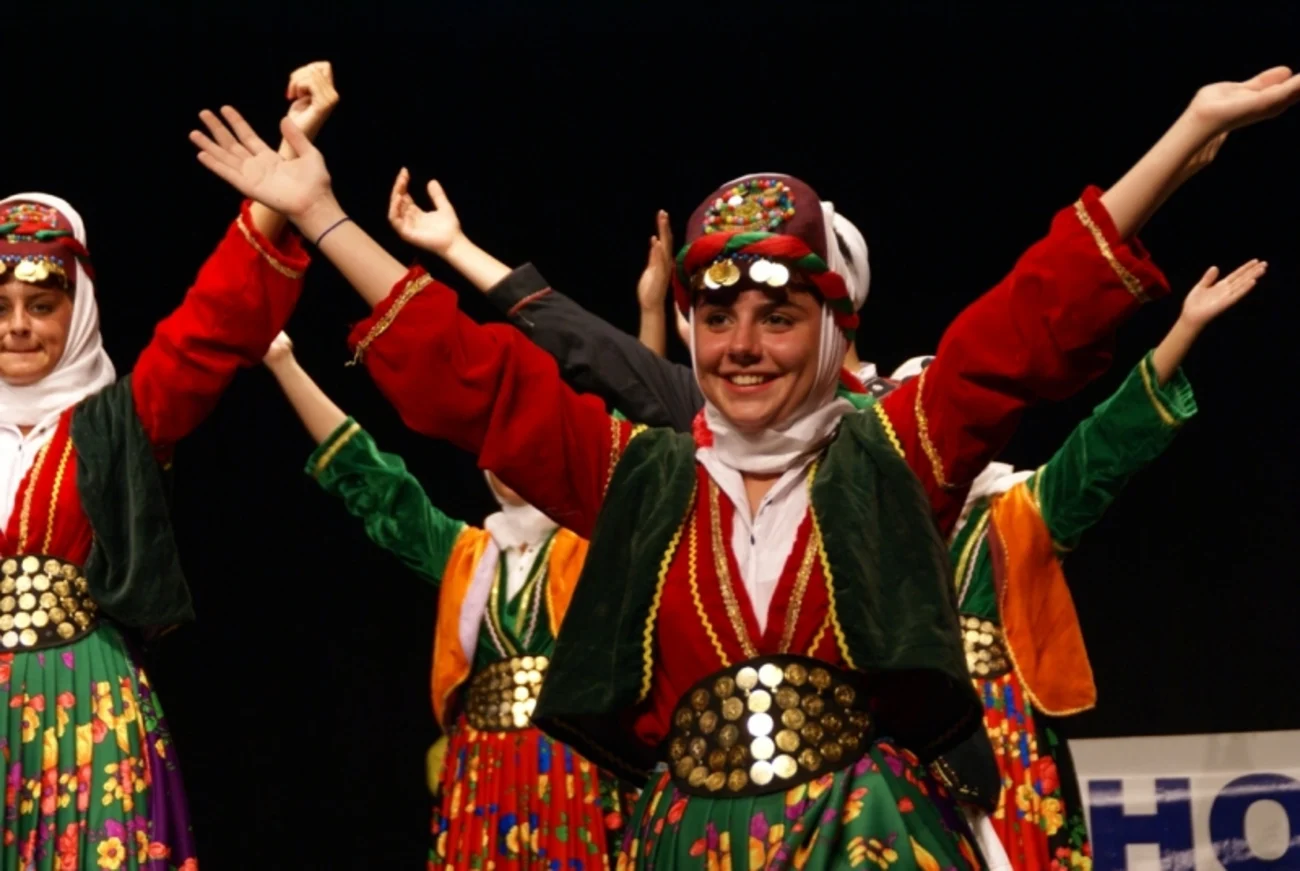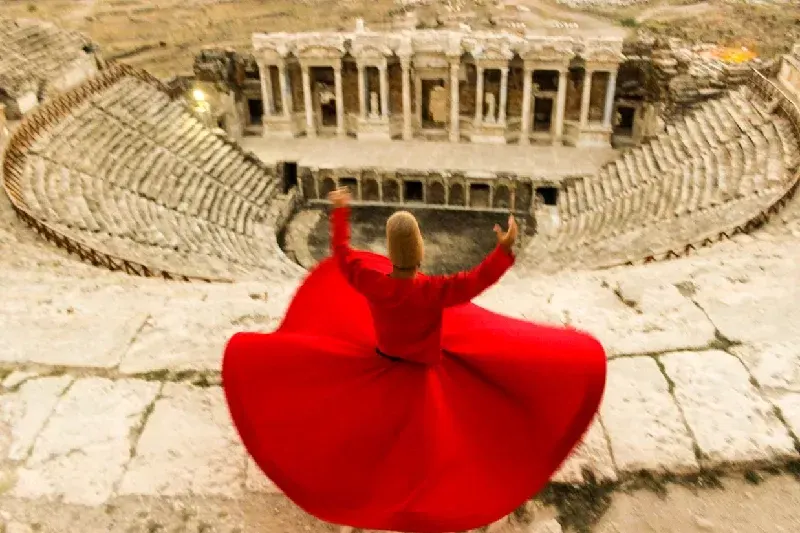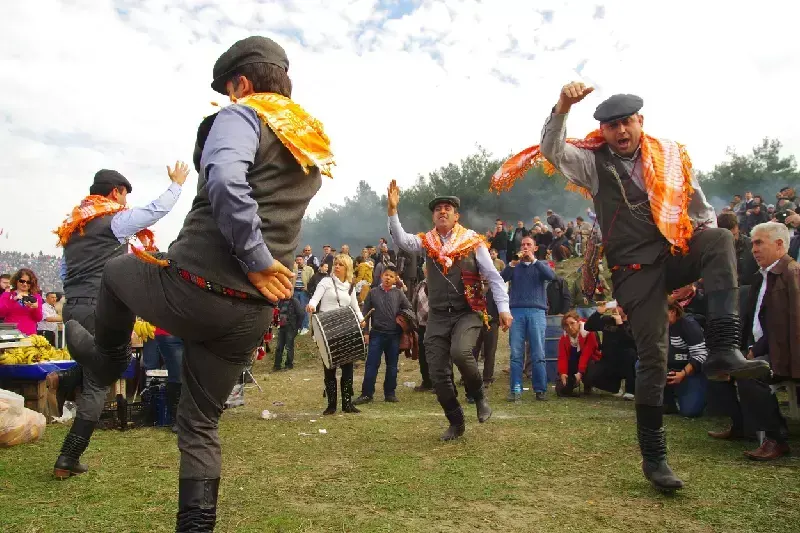Folk Dance of Turkey
Each region in Turkey has its own distinct dances, featuring unique movements and melodies. They play a vital role in celebrations, with traditional folkloric dances

Turkey is known for its sophisticated culture that reflects in various dances. These folk dances are standard at wedding ceremonies, national and regional festivals, meetings like the ferfene, yaren talks, and many more. Frequently, the dances are in open areas, but they can be shown in closed areas as well. Here, people enjoy themselves, exploring the wide variety of dance moves from different regions.
The standard form of dance you can come across is the line dance. Generally, there are numerous folk dances that are performed inconsistently to reflect the rich culture from every region. These dances include the Halay from the East and Southeast Anatolia, Konya, where the Horon dominates the area; the Hore is from Thrace, Zeybek from Aegean, and Bar from Erzurum. Their costume and way of presentation are imposing for any curious mind.
History of the Turkish Folk Dance
Turkish dance has its history and provenance deeply associated with its diversified regional and cultural background. Although Ottoman court life included such entertainers as Çengi and Köçek, Turkish folk dance remained largely within the villages and countryside and represented the traditional nature of their place.
During the Ottoman era, dance participated in court ceremonies and imperial celebrations, with performances taking place in grand spaces like palace courtyards. The Mevlevi Whirling Dervishes, a religious dance associated with Sufi practices, also became an iconic figure in Turkey's dance history.
Despite Westernization having an impact, Turkey has retained its strong dance heritage. Folk dance remains an important part of the culture, and many people attend dance schools or cultural centers to learn these traditional steps.
Here are dominant Turkish dances you can come across from the rich culture in Turkey.

Bar: A Vibrant Tradition from Eastern Turkey
Originating from Eastern Turkey, the Bar is a captivating, structured formation dance performed by groups in open spaces, often during festivals, weddings, and communal celebrations. Both men and women participate, moving in synchronized harmony side by side, their steps reflecting the rhythmic patterns of traditional Turkish music. The dance is accompanied by skilled instrumentalists playing folk instruments such as the zurna (a double-reed wind instrument) and the davul (a large drum), creating an energetic and immersive atmosphere. Dancers often wear vibrant regional costumes—men in embroidered vests and wide-legged trousers, and women in colorful dresses adorned with intricate patterns—enhancing the visual spectacle and honoring Turkey’s rich cultural heritage. The Bar is more than just a dance; it is a celebration of unity, identity, and the enduring spirit of Anatolian traditions, passed down through generations.
Zeybek
Originating from Western Anatolia, the Zeybek is a powerful and symbolic Aegean dance performed predominantly by men, embodying the virtues of courage, honor, and heroism. The dancers, known as Efe or Zeybeks, wear striking traditional costumes—adorned with richly embroidered vests, wide sashes, and feathered headgear—that evoke the legacy of Ottoman-era frontier warriors. The dance begins with slow, deliberate movements, reflecting dignity and strength, then gradually builds in tempo, culminating in a thrilling high-speed finale that showcases the dancers' agility and endurance.
Accompanied by the soulful melodies of folk instruments like the bağlama (saz) and kabak kemane (a bowed string instrument), the Zeybek follows rhythmic patterns in 9/4, 9/8, or 9/16 time, giving it a distinctive, rolling cadence. More than just a performance, this dance is a cultural emblem of resistance and solidarity, rooted in the history of the Aegean region. Today, it remains a cherished tradition at festivals, weddings, and national celebrations, preserving the spirit of Anatolian heritage through its dramatic movements and stirring music.
Customize Your Dream Vacation!
Get in touch with our local experts for an unforgettable journey.
Plan Your TripHoron
The Horon is a uniquely captivating folk dance, distinct from all other traditional dances in Turkey, originating from the vibrant Black Sea region. Its name derives from the Greek word "Choros," meaning dance, reflecting the area's rich cultural crossroads. This high-energy dance is characterized by rapid, sharp movements—quick steps, sudden drops, and synchronized shakes—creating a mesmerizing visual spectacle. Set to an exhilarating 7/16 rhythm, one of the fastest and most complex in Turkish folk music, the Horon demands precision, agility, and endurance from its dancers.
Accompanied primarily by the kemençe, a three-stringed fiddle with a piercing, resonant sound, the dance’s pulsating tempo is notoriously difficult to replicate with other instruments. Dressed in striking black outfits with silver trimmings, the dancers link arms in tight formation, their bodies quivering in perfect unison as they respond to the kemençe’s lively vibrations. Traditionally performed at weddings, festivals, and communal gatherings, the Horon is more than just a dance—it embodies the spirited soul of the Black Sea, uniting communities through rhythm, movement, and shared cultural pride. Its infectious energy continues to thrill audiences, preserving an ancient tradition that feels as dynamic today as ever.
Hora
The Hora is a vibrant circle dance that brings life and energy to wedding celebrations across Turkey. Performed to fast-paced rhythms in 6/8 or 2/4 time, the dance features synchronized steps, kicks, and spins as participants join hands and move in unison. The dynamic movements and spirited tempo create an exhilarating atmosphere, perfectly capturing the joy of a wedding. As the music builds, the dancers’ energy intensifies, drawing even spectators into the celebration. The Hora is more than just entertainment—it is a powerful expression of cultural identity, fostering unity and connection among guests while honoring Turkey’s rich traditions.
Rooted in Turkey’s Thracian and Marmara regions, the Hora is a cherished tradition passed down through generations. The circular formation symbolizes eternity and togetherness, making it a fitting centerpiece for weddings. Accompanied by lively folk instruments like the clarinet, violin, and davul, the dance’s infectious rhythm compels everyone to join in. Elders often lead the steps, teaching younger participants the precise movements and ensuring the tradition endures. The Hora transforms weddings into unforgettable celebrations, blending music, movement, and cultural pride into a whirlwind of shared happiness. It remains a timeless testament to Turkey’s vibrant heritage and the unifying power of dance.
Halay
Performed in Eastern, southeastern and Central Anatolia, this is an exotic Turkish dance with vibrant figure and structure. The dance is presented with a drum-zurm and a kaval to maintain the constant rhythm for the dancers to excite the crowd. This is the leading Turkish dances that are common in Turkey. Nevertheless, there are numerous dances in Turkish that you can explore.

Other Dance in Turkey
Kasik Oyunyu
The Silifke Spoon Dance is a vibrant folk tradition originating from the Mersin region and performed across central Anatolia, from Silifke to Konya. Both men and women participate in this lively performance, creating a captivating rhythm by clicking together pairs of wooden spoons while executing precise footwork and graceful movements. As dancers strike their spoons in perfect synchronization, they weave intricate patterns across the floor, their steps matching the energetic melodies of traditional instruments like the zurna and davul.
More than just entertainment, this dance carries deep cultural significance, reflecting the agricultural heritage of the region - the spoons symbolizing the utensils used in daily rural life. The women's flowing dresses swirl colorfully as they turn, while men display athletic leaps and stamps, together creating a dynamic visual spectacle. Performed at weddings, harvest festivals, and cultural events, the Silifke Spoon Dance preserves an important piece of Anatolian folklore, connecting modern communities to their ancestral traditions through rhythm, movement, and shared joy. The infectious energy of the performance inevitably draws spectators into clapping along, making it a truly participatory celebration of Turkish folk culture.
What makes the Silifke Spoon Dance particularly special is its dual nature as both musical performance and dance. The dancers transform simple kitchen utensils into percussion instruments, their spoon-clicking creating complex polyrhythms that interlock with the live music. This unique characteristic has made it one of Turkey's most recognizable folk dances, often featured in cultural exhibitions worldwide. The choreography varies by region, with some versions incorporating flirtatious interactions between male and female dancers, while others emphasize communal unity through symmetrical formations.
The dance typically builds in intensity, starting with slower movements that gradually accelerate to breathtaking speeds, showcasing the performers' skill and stamina. Traditional costumes enhance the visual appeal - women in brightly embroidered şalvar pants and vests, men in contrasting black and white outfits with distinctive belts. Beyond its aesthetic beauty, the Spoon Dance serves an important social function, bringing generations together as elders teach the techniques to children, ensuring the tradition's survival. Today, it remains a proud symbol of local identity, its joyful rhythms continuing to echo through Anatolian villages and cities alike, a testament to Turkey's rich cultural heritage.
Kolbash
Originating from the Black Sea region, particularly in Trabzon, Kolbastı is a dynamic and spirited traditional Turkish dance that has become especially popular among the youth for its energetic movements and modern appeal. Performed to fast-paced folk music featuring the kemençe and drums, the dance combines quick footwork, playful jumps, and rhythmic shoulder shakes, creating an infectious vibe that often gets spectators clapping and joining in. What sets Kolbastı apart is its blend of traditional steps with contemporary flair, making it a favorite at weddings, festivals, and even nightclubs, where young people reinvent it with urban styles while preserving its cultural roots.
The dance’s name, derived from the Turkish words kol (arm) and bastı (pressure), reflects its characteristic arm movements, where dancers often link arms or use them to accentuate the rhythm. More than just entertainment, Kolbastı represents the vibrant spirit of Turkey’s younger generation, bridging the gap between heritage and modernity, and ensuring the dance remains a lively symbol of communal joy and cultural pride.
Samah
Rooted in Sufi traditions, the Samah is a mesmerizing ceremonial dance performed without rhythmic instruments, relying instead on the haunting melodies of the ney (reed flute) and vocal chants in 9/8 time to guide its fluid, meditative movements. Dancers, often clad in symbolic white robes representing purity, spin and sway in circular patterns, their motions embodying the soul's journey toward divine unity and the sublimation of earthly desires. This sacred dance transcends mere performance, serving as a physical prayer where each gesture—from outstretched arms to bowed heads—reflects themes of surrender, longing, and spiritual awakening. Historically linked to the Mevlevi Order of Rumi, the Samah transforms space into a realm where the worldly fades, inviting participants and observers alike to contemplate deeper existential truths through its poetic rhythm and hypnotic grace.
Van and Adiyaman
The dynamic dance traditions of Van and Adiyaman have emerged as some of Turkey's most exhilarating performance arts, captivating audiences with their explosive energy and rich cultural symbolism. Originating from these distinct eastern regions, these dances transform ordinary gatherings into electrifying celebrations through their unique combinations of rapid footwork, synchronized group formations, and spirited musical accompaniment featuring the haunting mey (double-reed wind instrument) and thunderous davul drums. What makes these styles particularly powerful is their ability to adapt to various occasions - from wedding processions where dancers create human pyramids, to harvest festivals featuring elaborate mock-battle sequences that tell stories of local history.
The Delilo of Van with its graceful, swaying movements, contrasts beautifully with Adiyaman's more vigorous Halay variations, together showcasing Anatolia's diverse cultural tapestry. More than just entertainment, these dances serve as living bridges between generations, with elder masters teaching intricate hand-clapping patterns and symbolic gestures to youth, ensuring these traditions continue to pulse with vitality. Whether performed in village squares or on international stages, Van and Adiyaman dances never fail to awaken the collective spirit, their infectious rhythms and communal nature embodying the very soul of Turkish hospitality and shared joy.
Various dance groups are known to perform outstanding dances with exciting performances. Among them is the Caucasian dance group. The caucasian dance group is spectacular in Turkish dance performance or Dance of Turkey, serving as a must-watch experience for most visitors. Explore the Turkish culture with their amusing dances to lift your spirits. You can never get enough in this beautiful culture.
FAQS
Q1. What is Turkish Zeybek?
Zeybek is a Turkish folk dance from Western Anatolia, symbolizing bravery and heroism. Dancers, often in colorful traditional attire, perform slow yet powerful movements to dramatic music. You can experience this mesmerizing dance at a Folk Dance Festival Turkey, where cultural heritage comes alive.
Q2. What is Halay in Turkey?
Halay is a traditional Turkish folk dance performed in a circle or line, mostly in Eastern and Central Anatolia. Dancers hold hands or shoulders, moving rhythmically to lively tunes. It’s a highlight at weddings, celebrations, and Folk Dance Festival Turkey events, bringing people together in joyous harmony.
Q3. Where can I watch Turkish folk dance performances?
You can watch Turkish folk dance performances at cultural festivals, weddings, and Folk Dance Festival Turkey events. Major cities like Istanbul, Ankara, and Antalya host folk dance shows that showcase Turkey’s diverse regional traditions.
Q4. What are the most famous Turkish folk dances?
Some of the most famous Turkish folk dances include Zeybek, Halay, Horon, and Bar. Each dance reflects the history and spirit of its region. Attending a Folk Dance Festival in Turkey is the best way to see these incredible performances live.



















